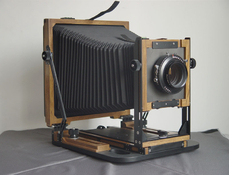Magnesium is fussy stuff and needs to be a special alloy with other materials to die cast well. That barrier was broken in the 80's. But what you almost entirely see today are lower quality softer aluminum-magnesium alloys which aren't very durable.
I don't think I'd want a camera made out of that, since there are better options.
I like the titanium hardware on my Ebony camera. But no way I'd be a sucker for such and such a marginally useful camera made of it. I'm an actual user, not someone looking for a conspicuous consumption fireplace mantle conversation piece next to the silver DeLorean parked on the rug.
My 8x10 is the original Phillips design (serial no. 009, in fact). He was the first to use custom plys, in this case, fiberglass bonded to veneers or expoxy-impregnated cherrywood. Now carbon fiber to wood plys have entered the scene and make lot of sense.
Durable, rigid, lightweight, and better thermal insulators than metal. And simply too light of a view camera is basically a kite in a breeze. You need some kind of sensible balance.
There have been aluminum monorail 4x5's clear down to 2-1/2 lbs, like Gowland and Toho. And some non-folding wooden models are nearly as light.
The aluminum alternatives that Drew mentions make perfectly good sense and are relatively inexpensive.
I have both a Calumet-branded Gowland ( dark-drawer-ware as I find it too fiddly in terms of solidly locking the movements ) and a 2.5 pound Toho FC-45X which is slick, elegant and good enough for practically any likely situation.
Well, and there's the wooden Nagaoka 4x5 field camera, just a few ounces heavier than the Toho. In the field, I'd be happy with either the Nagaoka, which is a delight to use, or the Toho, which has more than adequate movements. In fact, the fellow from whom I purchased the Toho had been using it for many years for commercial table-top photography in his professional studio.
When using light cameras like the above, your lenses, film holders, and tripod will compromise the most of the bulk and weight of your outfit, rendering trivial the saving of a few ounces on the camera itself from using expensive exotic metals. (Beryllium is more expensive than pure silver.)
If you want to keep weight down, then look at small, light lenses like the Kodak Ektar 203/7,7 and maybe a Fujinon NW125/5.6, along with a light carbon fiber tripod.








